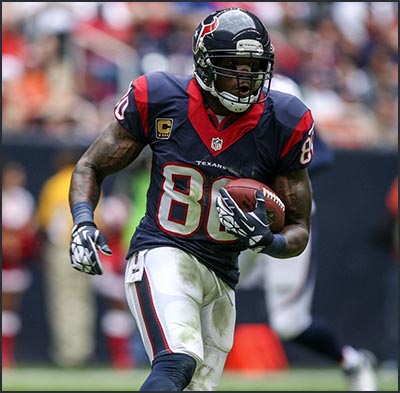Draft Decade: Wide Receiver Analysis, Part One
 It’s been a bit of time since I performed my last “Inside the Numbers” piece. If you’ve followed me for any length of time, you know these are annual pieces that look at a decade worth of NFL draft history relating to a single position. In most cases, I will only review the first round, although I have on occasion dipped into rounds two and three in order to find meaningful trends. Through this exercise, it’s far easier to see just how impactful, or not, rookie picks can be toward building your fantasy roster. Quite often, the results are surprising.
It’s been a bit of time since I performed my last “Inside the Numbers” piece. If you’ve followed me for any length of time, you know these are annual pieces that look at a decade worth of NFL draft history relating to a single position. In most cases, I will only review the first round, although I have on occasion dipped into rounds two and three in order to find meaningful trends. Through this exercise, it’s far easier to see just how impactful, or not, rookie picks can be toward building your fantasy roster. Quite often, the results are surprising.
For this exercise I’m revisiting the wide receivers. Every year as we reach the NFL Combine, our forums light up with fantasy owners dreaming of landing the next Calvin Johnson or Adrian Peterson. Questions continually roll into our article comment sections or email box about how best to utilize draft picks to one’s advantage. As would be expected, the value of draft picks can fluctuate wildly year over year as each draft class possesses its own unique characteristics with regard to depth, talent and tiers. Combine that with the fluctuations that will occur following the NFL Draft, as players are drafted into their new situations and you can quickly end up with an enigma wrapped within a mystery as to just how valuable a rookie pick can, or will, be.
What if I told you that this exercise has proven building your team solely through the draft is largely a fool’s folly? That’s not to say a spin of the wheel on draft day can’t provide a much needed spark to your roster, but if you expect to build your dynasty with rookie selections, you’ll have to be very selective, use all of your resources … and be very lucky. The percentages don’t lie. However, something has changed in the past four years (2009 – 2012) that is making this exercise more interesting.
Let’s take a look at the last ten years of draft history related to the wide receiver position to see how things have played out. As has been the case since starting this series, I will leave out last year’s draft as the rookies haven’t yet had an opportunity to become fully accustomed to their teams, playbooks or the speed of the NFL. This helps, if even only a small amount, to normalize the percentages such that those appearing in the study have at least a year of experience before being included. So for this exercise, we are looking at years 2003-2012.
During this period, there were 38 receivers selected in the first round of the NFL Draft. Over this same period, there were 42 receivers selected in the second round.
Looking at those selected in the first round:
– 15 (39.5%) were selected within the first ten picks
– 7 (18.4%) were selected within the first five picks (there’s a reason I break this out).
The seven receivers who were taken in the top five picks of the NFL Draft were:
Charles Rogers (#2, 2003)
Andre Johnson (#3, 2003)
Larry Fitzgerald (#3, 2004)
Braylon Edwards (#3, 2005)
Calvin Johnson (#2, 2007)
A.J. Green (#4, 2011)
Justin Blackmon (#5, 2012)
This is a relatively good list of players, showing that a receiver taken in the top five selections is a good bet. I can even make the case that both Rogers and Blackmon had elite talent and were only derailed due to drug related issues. There’s still plenty of time and potential left for Blackmon, but the risks here are well known. For Rogers, a player who I drafted myself, I still recall his first NFL game against the Cardinals in which he scored two touchdowns. He would score only two more in his career. He had elite talent, speed and skills, but couldn’t overcome work ethic and drug related demons. As for Braylon Edwards, his 2007 campaign saw 80 receptions, 1,289 yards and 16 touchdowns – totals he wouldn’t approach again. He was a spot starter in fantasy, but just couldn’t lock down any real level of consistency.
Here are a few other notable receivers along with their drafted information:
Roddy White (#27, 2005)
Dwayne Bowe (#23, 2007)
Hakeem Nicks (#29, 2009)
Percy Harvin (#22, 2009)
Jeremy Maclin (#19, 2009)
Michael Crabtree (#10, 2009)
Dez Bryant (#24, 2010)
Demaryius Thomas (#22, 2010)
Julio Jones (#6, 2011)
Kendall Wright (#20, 2012)
Michael Floyd (#13, 2012)
Without listing every receiver, I am going to classify each of the 38 as one of my four rating categories: Stud, Starter, Bench and Bust. The break down of the 38 receivers is as follows:
Studs – 8
Starter – 8
Bench – 3
Bust – 19
Of those eight studs, four of them came within the first five picks of the NFL Draft, and Julio Jones was selected at #6. Let’s review some percentages now from the first round:
– 63% of studs were selected within the first six picks of the NFL Draft
– 21% chance of getting a stud from a first round wide receiver
– 8% chance of getting a stud selected after pick #6
– 42% chance the receiver will be at least a starter
– 50% chance the receiver will bust
– 58% chance the receiver will be no better than a bench player
I mentioned previously there has been an interesting development over the previous four years that has been noteworthy. Beginning in 2009, first round selected receivers have been far more productive than the five years previous. So much so, in fact, that the decade percentages have become far more favorable for receivers. Whether this is due to better scouting, size or perhaps better collegiate training, it’s something that cannot be ignored. As a note, 2008 was the only year in which no receiver was selected in the first round. Over this period, 15 receivers were selected in the first round.
Just a couple of quick stats looking at the previous four years (2009 – 2012 ) only:
Studs – 4 (26.7%)
Starters – 6 (40%)
Bench – 1 (6.6%)
Bust – 4 (26.7%)
– 26.7% chance of getting a stud
– 66.7% chance a first round receiver will be at least a starter
– 26.7% chance a first round selected receiver will bust
As you can see, at least when only considering the four years of this period, receivers have become more productive. While this is not enough sample data to declare that the receiver field has materially changed, it will be something of interest to consider over the next five years of drafting, especially given the receiver-heavy status that 2014 looks to be.
If a wide receiver draft was akin to a Vegas game-table, it would offer the worst odds in the house. The previous five years is offering hope for the position, but even given that fact, there’s still a 58% likelihood that your NFL first round receiver will rarely get off your bench, with a 50% chance of him busting completely. With the 2014 rookie draft heavy at the receiver position, a fantasy coach should temper his expectations, yet that isn’t likely to occur. The draft provides too much allure and hype for most to allow reason to prominently factor.
For myself, I’ll be looking to trade out of any relatively high rookie selection that doesn’t equate to Sammy Watkins. And even a selection of Watkins outside of the top six selections in the NFL Draft, will offer more risk. It’s what the numbers tell us. If you are receiver-needy, why not consider a trade for a productive receiver now, rather than spin the wheel?
In part two of this series, I’ll be looking at those 42 receivers selected in the second round of the NFL Draft during this same period of time.
- Lineup Advice: Wrap-up, Thank You and Goodbye (TTFN) - January 1, 2024
- Lineup Advice: Week 17 – Championship Edition - December 26, 2023
- Lineup Advice: Week 16 – The “What is” Edition - December 19, 2023


































































